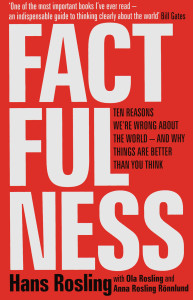Factfulness
by Hans Rosling
Published by Sceptre www.sceptrebooks.co.uk
I’d like you to imagine a better world. A world where 80% of the world’s people rather than 20% have access to electricity, where 80% of children rather than 20% have been vaccinated and where 90% rather than 60% of girls are enrolled in primary education. Now squint your eyes and furrow your brow and wish real hard for that world… Wow! You must have wished super-duper hard because it worked!
Not convinced eh? Okay, I fibbed a bit about the wishing but the numbers are real. Enormous change for the better has swept the world in our lifetimes says the late Hans Rosling in ‘Factfulness’. Almost everybody, almost everywhere is healthier, better fed, educated and richer than ever but it’s a change we missed because our instincts lead us astray.
Rosling starts off his book with a little multiple-choice quiz covering a bunch of population metrics from income and violence to child mortality and education. It’s a quiz he’s given during hundreds of lectures to everyone from school kids to members of the World Economic Forum. Regardless of age, education or experience, every audience scores way below average. There’s something in the human psyche, some instincts, that makes us want to see the world in the darkest possible light despite decades of steady improvement. In ten chapters, Rosling explores just what those instincts might be and gives us some tips (handily summarised at the end of each chapter) to counter our built-in ‘somber spectacles’ that lead us to think all is lost when actually all is to be gained.
The ‘third world’ we grew up with no longer exists says Rosling. Instead he divides the world into four income dependant sections from the dollar a day extreme poverty of Level 1 to the $30 a day wealth of Level 4. The gap between us and the world of famine, war and natural disasters on TV is not a gap at all. Some five billion people live there. Not poor, not rich, they get by on very roughly $10 a day (and if you think $10 a day isn’t much, ask the man who has $1). That’s five billion people with access to food, medicine, electricity and education who are working, raising families and leading ordinary, peaceful lives. Even the Population Bomb seems to have bombed. According to the UN, 90% of the world’s parents – regardless of their country or religion – already average just over two children and that number is dropping (Iran has a lower birthrate than the US).
This would make headlines if it happened overnight but it happened over 20, 30, 50 years in increments so small that even the people it was happening to hardly noticed. When journalist Lass Berg returned to an Indian village he photographed in the 1970’s, the well dressed, TV owning villagers in their concrete houses refused to believe his photos of earth floors, clay walls and half naked children – “that can’t be here, we were never that poor”.
Rosling isn’t some Panglossian Pollyanna pretending all is sweetness and light. A billion people are still desperately poor, wars and repressive regimes beset the world and global warming is a challenge to all. He is though (or rather was until his death last year), a cheerleader for the human race. Through his Gapminder Foundation website, worldwide lectures, Youtube videos and TED talks (all highly recommended) he reminds us that yes, we have some way to go but look how far we’ve come! A hundred years ago nearly 90% of people lived in grinding poverty. Today that’s down to 9%.
‘Factfulness’ definitely oversimplifies some things but this isn’t a grim book of warnings telling us to save the world, it’s a book of hope showing us we already are.
